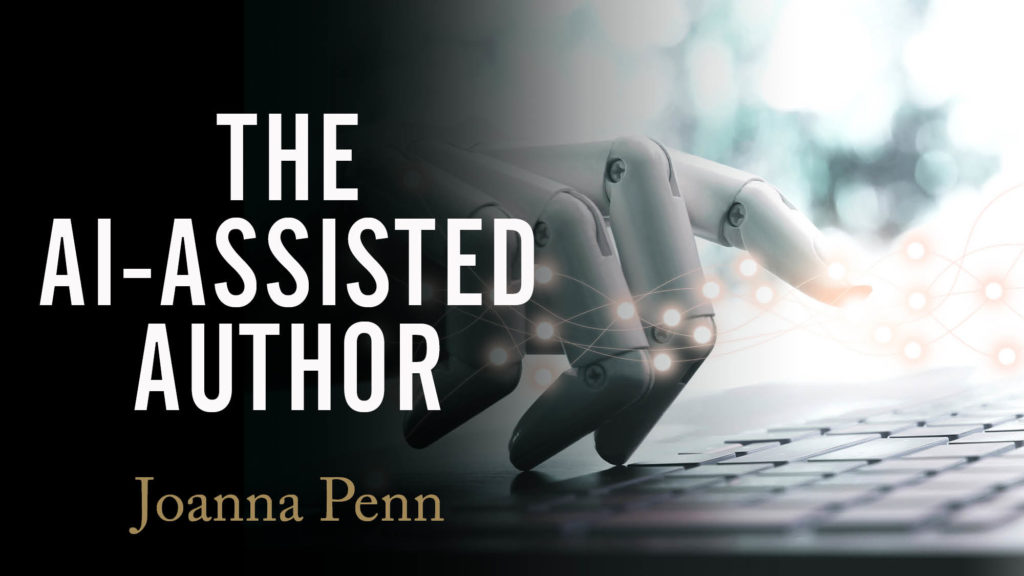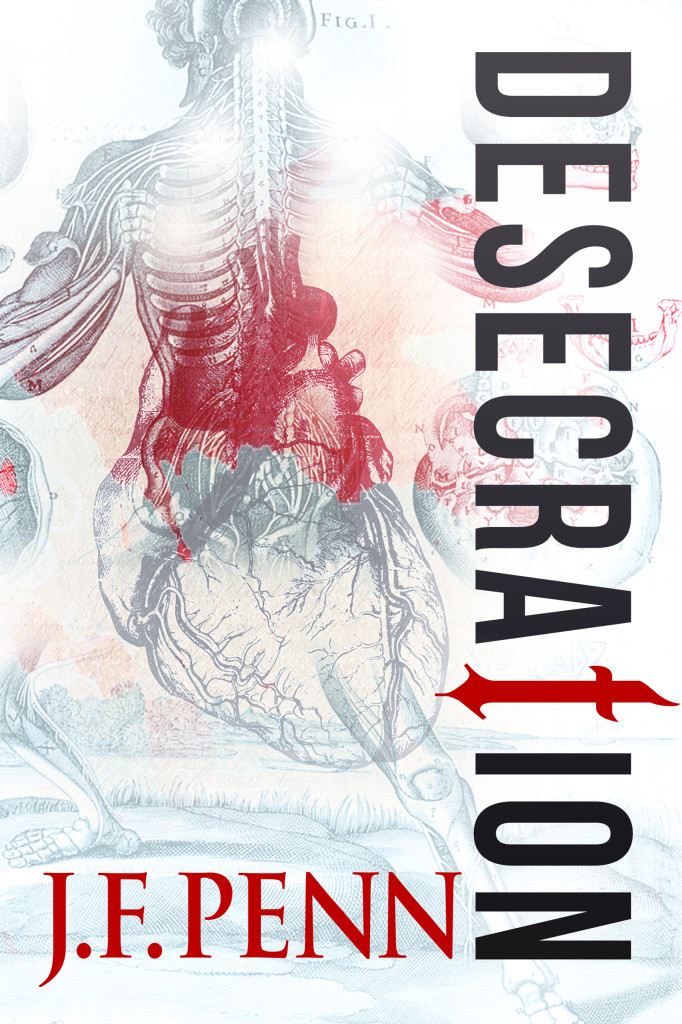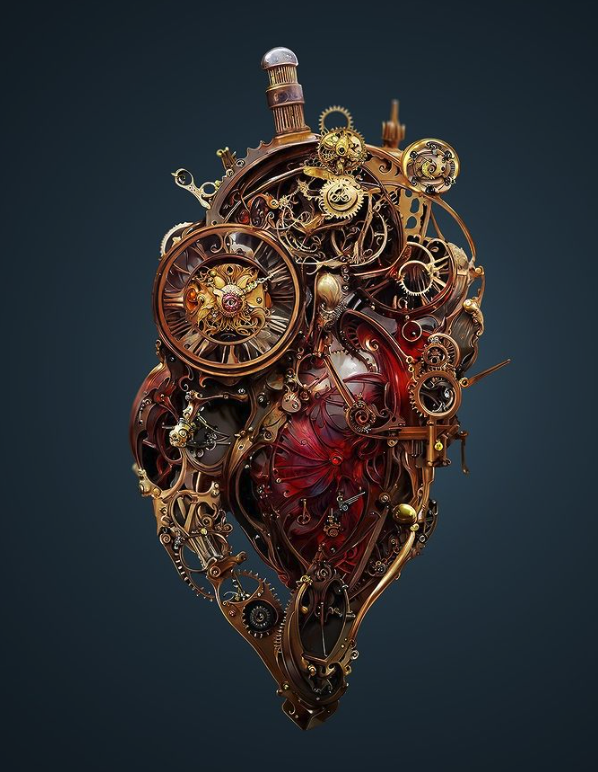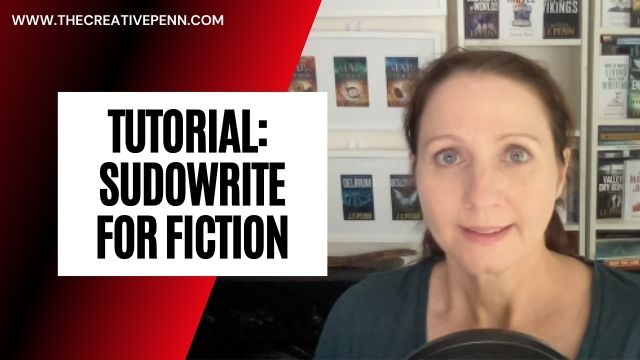Generative art tools like DALL-E, Midjourney, and Stable Diffusion are taking AI art into the mainstream. What are the opportunities for authors? What are the problems and controversies to be aware of? I talk about these issues and more with Derek Murphy.
In the intro, I mention my J.F. Penn NFTs with AI-generated art based on words from my novels; Microsoft will incorporate DALL-E into design products [TechCrunch]; Meta’s Make-A-Video and Google’s Imagen Video [TechMonitor].
If you’d like to know more about using AI for writing, images, marketing, voice, translation, and more, check out my course, The AI-Assisted Author. You can also find more podcast episodes and tools at TheCreativePenn.com/future.

Derek Murphy writes urban fantasy, YA, and romance fiction as D.S. Murphy, as well as books for authors on writing and marketing. He has a Ph.D. in literature and is also a visual artist, designer, and course creator.
You can listen above or on your favorite podcast app or read the notes and links below. Here are the highlights and the full transcript is below.
Show Notes
- Why AI art is such a fascinating emerging area — and how it can help existing artists improve and iterate their creative ideas faster
- The tools available — DALL-E 2, Midjourney, and Stable Diffusion
- How prompting works and determines the quality of your output, and why iterations and curation are so important as a creative director with a vision
- How AI art generation tools might replace stock photography sites
- The problems with AI-generated art, including the use of living artists as models, copyright, and more
- Using AI images for ads and emotion-driven content that might help sell more books
- How book cover designers and other artists can use AI tools in an effective way
You can find Derek at www.Creativindie.com and on Twitter @creativindie. You can go through Derek’s Midjourney tutorial here.
Transcript of the interview (lightly edited)
Joanna Penn
Derek Murphy writes urban fantasy, YA and romance fiction, as well as books for authors on writing and marketing. He has a PhD in literature and is also a visual artist, designer and course creator. So welcome back to the show, Derek.
Derek Murphy
Hi, thanks for having me on. It’s been a long time since we’ve talked.
Joanna Penn
It has indeed. And I mean, you and I go way back. Now you designed some of my early book covers —
Derek Murphy
I want to say it was like 15 years ago or something, I think I found one of your books in Portland, a long, long time ago. And I was really excited. Because I wanted to be a writer. So that kind of got me on to the path.
Joanna Penn
Yeah, I mean, it’s kind of crazy how long we’ve known each other online. But you were on the show in 2014 talking about book cover design. I can’t believe how time passes. But give us a bit of an update.
What does your author business and your author life look like right now?
Derek Murphy
Sure. I started with fine art. I was a painter. I did my PhD in literature. And then I was doing editing and painting. And then I transitioned towards book cover design. So I did that for quite a long time.
But book cover design has changed a lot in the last 10 years because of all the new technologies. But in the last few years, I switched more to passive income with some courses, so that I can focus on my fiction. And in last, basically, five years, I think I’ve written like 20-something novels, but I haven’t finished a whole series yet.
And this month, I’m finally finishing a full series, which is kind of a big deal. So I’ve been doing just enough work to get by. But now that I have a finished series, I think I can focus more on my fiction as income revenue, which hasn’t been the case so far.
Joanna Penn
What’s your fiction name? So people know.
Derek Murphy
I use DS Murphy. And then I also use Drake Mason as a pen name. And it’s mostly like Twilight with mermaids and vampires and things like that. So young adult, plot-heavy fantasy, I guess.
Joanna Penn
That’s cool. And we might come back to the mermaids because you’ve got some cool stuff on that too.
I wanted to talk to you because I know you’re a multi-passionate creative, you’re very visual, also with words, obviously. But today, we’re talking about AI for art, which is pretty contentious in the world as we record this in October 2022. But let’s start with the attitude to AI.
Why are you interested in AI as someone who’s done some pretty traditional work in the creative sphere?
Derek Murphy
Right. So as an artist, I understand the frustration, because it’s weird. Like, I was never the greatest artist.
I had really big ideas, and I just couldn’t execute them with oil painting. Now I could recreate the same idea much better in a minute. And it just looks awesome.
So I’m not exactly torn, because I like the art that I’m making, I think the AI art is, is really, really good looking. It’s really fast, I don’t have to pay a lot of money for designer and wait for designs.
So for me, it’s new enough that when I share images, it’s going to make a really big difference in marketing. I’m not totally sure if I’ll use them for coverage yet, because we’ll discuss later, you know why or why not? But it looks so good that when you put it up online, people are like, wow, how did you make that? Where did that come from? Are you the artist?
So real artists are getting really upset because they don’t feel like AI art is ‘real’ art. They think that art requires skill and hard work, or passion, like the struggle to create something is where the art comes from.
And if it was just made quickly, no matter how beautiful it is, it doesn’t count, because there was no struggle.
I don’t really believe that. I think that’s kind of a leftover of the starving artist mentality where, like the same discussion you hear with people who write books quickly. And they write lots of books, because they know what they’re doing.
People who are still struggling with their first book, say, ‘Well, my book was hard work, I suffered from my art.’ So my book is art, even if nobody likes it, whereas those people who just pump out books, it’s not hard, even if they sell a lot of copies, and the readers love the books. I think that’s a weird argument to make. But it’s the mindset a lot of creative people are kind of stuck on.
Joanna Penn
No, I agree. And I was actually going to use that example, too. What is ‘real’ art?
If the viewer likes and has an emotional connection with what they’re looking at, in the same way that a reader can read a book that was written quickly and love it, and they can read a book that took 20 years to write and they didn’t love it.
We have an opinion as a creator, but the opinion of the person on the other end, the consumer can be completely different. Right?
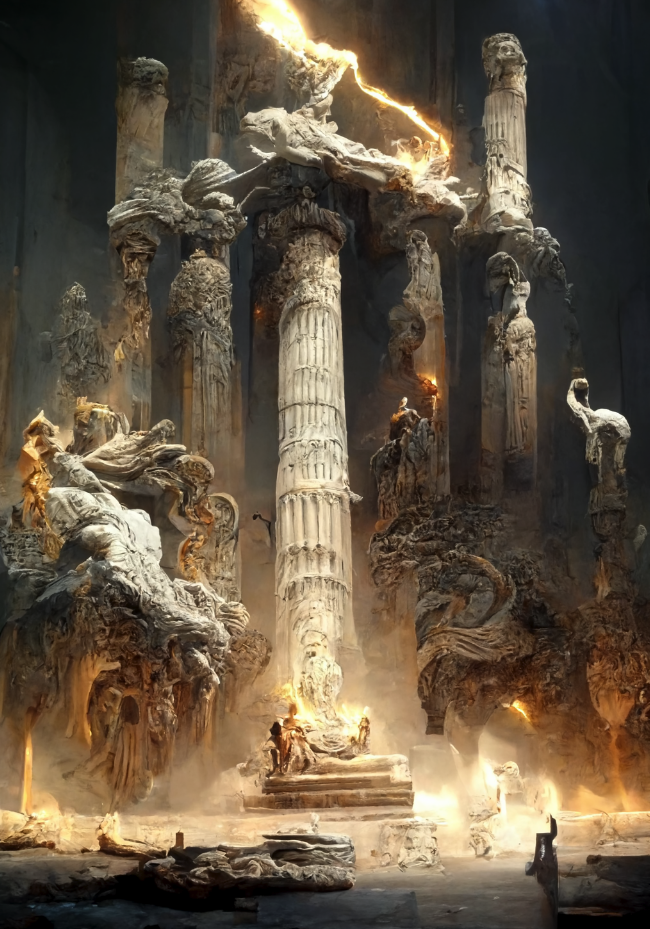
Derek Murphy
And I figured that out a long time ago when I started my blog, Creativindie. I was a starving artist. And I just wanted to do my thing and believe in my art.
But at some point, you have to figure out that real art has value to other people, it impacts other people in an emotional way.
And you can’t control that. It doesn’t matter how much time or effort or intention you put into it, it comes down to — does the market respond? Does the audience respond?
So some creative people think that that’s selling out if you make something that other people like, but I think that’s kind of just the definition of good art.
It either works or doesn’t. So I’m pretty functional, in that I could make tons of things. But I want to make things that people like and hopefully enough that they like enough to pay for so that I can keep making more of the art that I want to make.
Joanna Penn
Absolutely. Okay, so the reason I emailed you, obviously, I know you online, but I had no idea you were into this AI stuff.
You did this great article about creating with Midjourney.
And then you put up another one of Black mermaids which I thought was brilliant to riff off the controversy around that. And you’ve produced some beautiful images. But tell us what you’ve been doing.
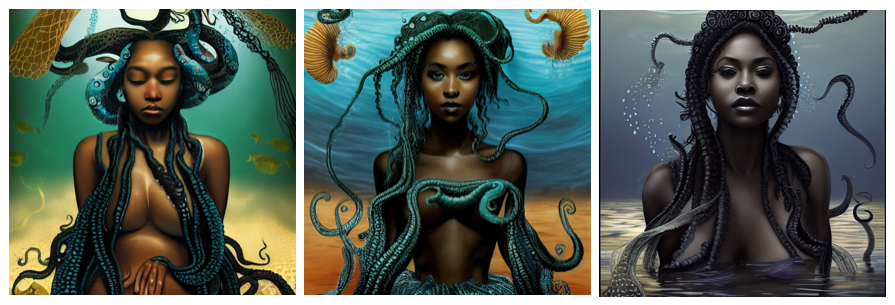
What tools have you been you’re using, and how does your prompting work?
Derek Murphy
Sure, I’ve been using Midjourney more than the other tools. There are three or four main big tools, and they’re all a little bit different.
So Midjourney is the first one that came to the public. It’s the fastest growing one. And when I started this, I think it came out to the public like three or four months ago. And my first ones weren’t that great.
But already every week, they’re getting much, much better. The art that I’m putting out now is already way better than the stuff from just a month or two ago. And with Midjourney, they are all text-to-image prompts.
So I type in dark-skinned mermaid under the sea. And then I can just type in famous artists or famous styles, I can change the ratio or the resolution, I can add detail, but does make quite a bit of difference how you organize your prompts and your text.
Sometimes you’ll get something amazing just by describing what you want. I’ve even seen some really cool stuff with like, take a quote from your book, or take a review from your book, or a scene from your book and just put the text in, or like a Bible quote, I’ve seen some really cool things.
But you can also just describe, you know, I want a girl standing in a meadow with a vampire skull and a dagger or whatever. And it’ll try to figure it out, it’ll probably get it wrong for a while.
But once you get something that’s pretty cool, you can just re-spin it. And the really interesting thing happens when you keep re-spinning.
So I’ll go through something for a couple of hours until I find something that’s really neat. And then it might take me another day or two and 1000s of images where I’m just really spinning the same thing.
And it’s giving me slight variations with more detail, until I get some things that are just off the walls crazy.
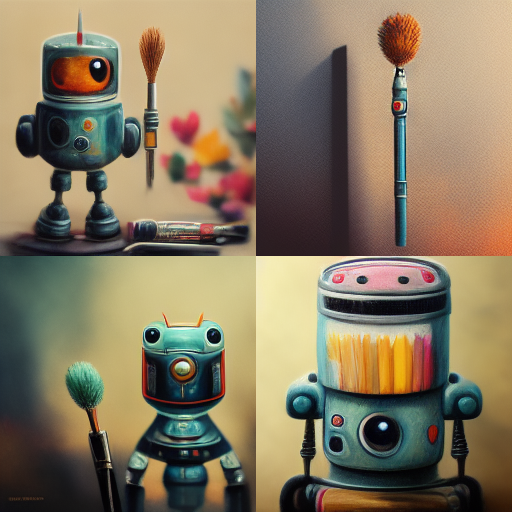
Because you can get something very nice, which is comparable to stock photography, and high-level creative concept art like character design. But you can also get something that’s just mind blowing, basically.
And that’s what you kind of want, because you have a unique opportunity right now to make art that hasn’t been seen before that people haven’t seen before. That’s not a stock photo, that just cool enough to share. But that’s what I’m really excited about.
Also just the variety. So if I had made one, like mermaid picture, it’s not really a big deal. But if I make 100 of them, I can basically own the internet. I can get all the search traffic, just for that post, anybody who is searching for images of black mermaids, there’s not going to be a lot out there, or they’re going to be really spread out and I can kind of host them all in one place.
So like you mentioned, I can cash in on the controversy a little bit by claiming that search traffic. And then I also write mermaid books. So once they’re on my side, I can try to detour them towards something else.
Joanna Penn
The first thing I want to come back on is the process. So I’ve got a course on the AI-Assisted author. And I think it’s really difficult for people to imagine until they try this.
Essentially it’s a prompt, followed by iteration, and then curation of the output.
Because as you said, it is not hard to generate an image. What’s difficult is getting the right prompt that takes you in the creative direction you want.
And then iterating through the process, finding things that match or a heading towards what you want. And then a curation of the final output, right?
And it’s almost like people think there’s an easy button, but you mentioned there a couple of hours and then a day or so to kind of put all this together.
So as someone who also creates your own art from scratch, how has this changed the way you think about generating images or even text or music or whatever?
How does the human artist work with the AI tool and drive it in the creative direction they want?
Derek Murphy
I think most people, they would make art because they need it for something. Most authors, especially.
I bought all sorts of digital assets, I bought music or videos, because I want to use them in a video or an advertisement. And I buy stock photography, if I want to use them in a book cover design.
But this means I don’t have to buy those things.
So the really interesting thing is gonna be right now, there are huge marketplaces where you can buy digital assets. And there are people who make those assets and everybody else who just needs something. And so they paid to download it, this was going to bypass a lot of marketplaces, and new marketplaces are already emerging.
There’s already a stock image site where you can type in a prompt, and instead of finding existing images, it’ll just generate new images for you.
I think that’s going to be a big model going forward. So it’s going to really threaten stock photo sites, and the photographers are the artists who sell their work that way, because this is just a new way of creating the content that people need.
For book covers, specifically, like when I started, I had to just use stock photos. So if I wanted to do a sci fi or fantasy cover, that was really hard, because I couldn’t find a detailed glamorous armor, girl in a dress in the forest or whatever, I’d have to Photoshop all that together with a bunch of random pictures.
And I could do it, it would take a long time, but I could do a pretty good job of it. And then in the last five years or so people started using 3D renders instead. They can create like a mock up model and render that 3D character and then add a background and add text.
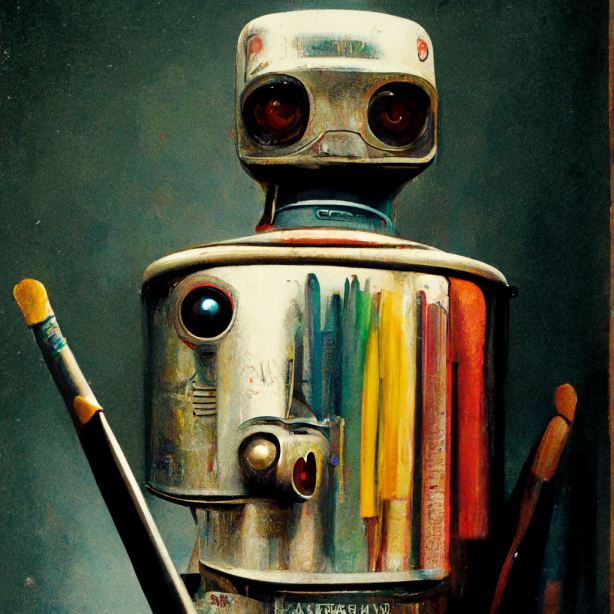
So the covers got much better in the last five years. But they all sort of look the same, which is not a problem at all. For me, I think covers should look the same, I think you shouldn’t be trying to make a cover that looks like the other covers in your genre, so that you fit in.
And I’ve always kind of told people, I don’t really recommend custom illustrated art, because that’s not really what selling in most genres, it’s too hard to produce, it doesn’t really look as good. So I would like photo manipulation for book covers.
And I still basically believe that, but the art that I’m already making with AI, right now, the problem is that it’s much better than the book covers that I’ve already designed. So I’m excited to use it, because I can get a lot of visibility for it, because it’s something that stands out just by looking really cool.
But I have to also make sure that my book covers match the art I don’t want, like if I’m using Facebook ads, and my art is amazing. And then I clicked over to my Amazon page, I can use the same images for my A plus content. But if my cover doesn’t match the vibe, or the mood of my really cool, I may have to redo all my covers as well to kind of make sure that they mesh.
I think it’s an exciting time because we’re still at the edge of it.
So like I’m excited to finish my series right now, because I can use all this stuff. Right now, in another year. I think most authors will be using this in some capacity.
Joanna Penn
I know what you mean. It’s interesting. You mentioned for stock photography. And as we record this again, at the beginning of October 2022. It’s very important to timestamp it because things changed quickly.
Some of the stock sites have banned purely AI content, but equally said they will support artists who use generative art as part of their process.
And I was talking to my brother yesterday who is a fashion designer. And he said that a lot of people are using Midjourney to come up with concepts that they then tweak to turn into 3d designs for new fashion.
And I’ve seen this I’ve seen some amazing of people go on social media. If you go on, say Instagram and use #midjourney, and Twitter, you can find amazing art with fabrics. It’s just beautiful.
You can do an AI picture. And then you can put it in Photoshop, and you can change it. So where’s the line? And I find this so interesting.
Where’s the line between 100% AI to 100% human? Do you think we will move that slider up and down every time?
Derek Murphy
I’m going to discuss some of the other tools. Midjourney is great with details. So does amazing, like beautiful dresses. It does really good illustrated art like traditional fantasy, like a 1980s sci-fi poster, or something like that.
But it also has really good photo-realistic stuff. So I can get like a photo image of a character instead of using a stock photo, a face that is going to be on a bunch of other covers, and get something that’s really unique. That looks like a photograph, but it’s too pretty to be real. Like I couldn’t have made it even with photography, but it’s now aren’t quite there yet on all of the details.
So if I want to make a complex scene where the character is standing with a dragon behind them, and a castle on a mountain somewhere, I can’t dictate where all of the pieces are going to show up, and it gets tricky with like hands and fingers and faces, because it can’t do everything all at once.
But sometimes it sort of guessing in one direction, it’s a little bit closer, and then you go in that direction. Right now, most of my art, I could like for some of my book covers, if I want to use them for book covers, it’s not quite there yet with Midjourney.
And I’d have to put them all in Photoshop and choose different elements and then maybe replace the face or fix the hands and fingers. I think in another month or two, I don’t think I’ll have to do any of that. I’m not really in a rush, because I think soon, it’s just gonna be perfect. And then there’s not really any sense in going back to Photoshop.
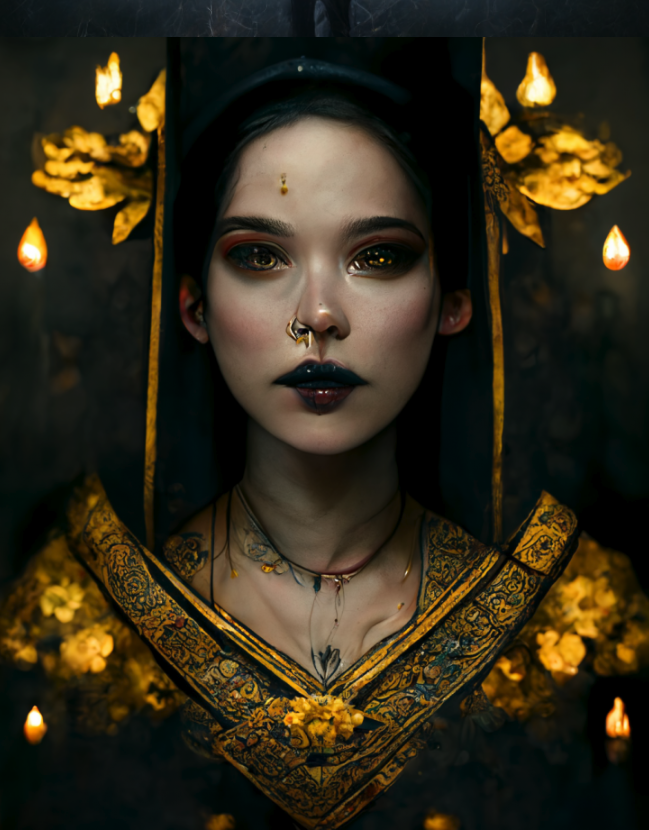
And the nice thing about Midjourney is that it does really good with emotional scenes. The problem with Photoshop is, if you’re not very good at Photoshop, you can put all the elements together, you can put the character in the background and the text, but it just won’t look very good.
And it won’t look very emotional, the best you can hope for is that it communicates the genre really well, which is what you want. But it would be great if you can also hook them with a really strong emotion, like this is just beautiful artwork. And Midjourney does that really well.
The other one, that’s I don’t think fully public yet is DALL-E 2, but it will be fully public in another month or so. I think DALL-E 2 is smarter, but it’s not pretty.
So some of the tests I did, for example, I want this artwork where the Grim Reaper is kind of, he’s got his arms wrapped around this girl in a white dress. So that positioning between two characters is really tricky. I can’t get Midjourney to do anything quite like it. So I’d have to Photoshop Elements together to make what I want.
But in DALL-E 2, I can already put in some other artwork, that is the idea that I want the concept that I want. And it will understand the scene well enough to recreate the scene, you know, like basically a grim reaper with his arms around the girl flying away. It’s ugly in DALL-E 2, but it understands the concept. And it gets much closer to what’s the idea of this piece.
I think Midjourney is more beautiful and probably always won’t be more beautiful. But DALL-E 2 is probably smarter.
And then the other big one is Stable Diffusion. The way I understand it, Stable Diffusion basically can upgrade your art.
So you could sketch something yourself, you could hand draw some idea that you want to do, and then pick a style or whatever. And it will basically get the idea and then recreate it into art.
I think that’s amazing, especially for a lot of artists, like I wish I could have all of my old oil paintings, which are good ideas, but maybe not executed very well, I could just put it in Stable Diffusion, and it could just fix everything and make it beautiful. That’s a really cool tool that I never had access to when I was doing fine art.
Joanna Penn
I mean that those are your original paintings. And so probably you feel fine about using those as almost like a prompt. So just to explain to people. So I played around with a tool that was built on the original DALL-E earlier this year.
My first NFTs were essentially Special Edition books with an image that I built using AI generation from my text.
And that was back in like March I was doing that. And what’s interesting is exactly what you say. So I used just a basic pair of wings. Like here’s some wings as a image prompt plus text from my book A Thousand Fiendish Angels. And then I asked it to do it in the style of Leonardo da Vinci’s notebooks.
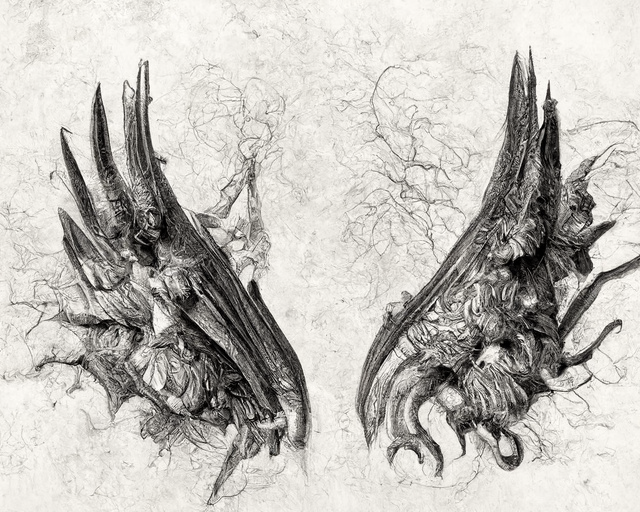
And I got some beautiful images of these anatomical drawings of demonic wings, which I then minted as part of my NFT process.
But why I’m mentioning that is because I used Leonardo da Vinci’s notebooks as a part of the prompt so that the AI knew what style and you’ve talked there about using different styles. And this is part of the problem, right?
Let’s get into some of the controversies. Leonardo da Vinci doesn’t care. He’s long dead and also out of copyright.
But many people are using living artists’ work as a style prompt. What are some of the problems with that?
Derek Murphy
Sure. So that’s the easiest way to get started. But also, of course, it has big differences, big controversies and difficulties because what everybody else is saying is that all AI are stole content from other artists.
So you can’t trust any of it because we don’t really understand how it works or where it’s pulling its sources from so because it ‘stole’ all these pictures from all over the internet, so we have to be very sensitive about using it.
So that’s on the back end of how the art was made, how the model was trained. It looked at millions and millions of pictures.
A lot of those pictures were from stock photo sites to take one example. So it looked over, maybe I stock or deposit photos have looked at all those pictures.
And legally, the way it works is that it’s not illegal, because everybody can get inspiration from looking at a picture.
I’m allowed to look at a bunch of stock photo pictures to get an idea and then create new art, I don’t have to buy every picture that I looked at, if I’m not actually using I’m using it as inspiration. But I’m not like copy and pasting a little piece of this picture.
People are trying to argue that it shouldn’t be legal for AI to do this without permission, especially when they’re going through Deviant Art. And they’re looking at a bunch of artists portfolios. And that’s where they’re getting the inspiration.
It gets really tricky for like sci fi, and fantasy, because there aren’t a lot of stock photos of things that don’t exist for obvious reasons. So the only way that they can know what this looks like, is by all of the fan art that’s been made, like Lord of the Rings, fan art, or Star Wars fan art, and there are millions of pictures, but they required a real artist to create in the first place.
Now AI can create something similar very easily, but only because of all the humans that went before.
So that’s why people are upset.
But it’s not illegal, because they’re not really using the image itself, they’re just looking at it for inspiration to create something different with the prompts.
If you’re using a specific prompt of a specific living artist, right now, that’s an easy way to get some good results, I think probably, there’s a strong legal case for those artists to sue to get their names blocked.
And that’s already sort of happening in Midjourney where certain terms are banned. So you just can’t use those terms. I don’t know how they’re going to deal with it, because I think every artist would have to bring their own law case. And most artists just aren’t going to bother doing that. But I think we will see that they might just, you know, a blanket statement, you can’t use the names of any living artists. But that means like, somebody’s got to go through those millions of names, and figure it all out. I don’t know if that’s ever gonna happen either.
Joanna Penn
Just to be clear for people listening, as far as I can see, and from what I’ve read that it is not plagiarism. So plagiarism can only be on the output.
If I download one of your books, and I upload it under my name, or I take your piece of art, and I publish it under my name, that is plagiarism.
But the art that the AI is generating, it’s not plagiarism, it’s learned and it’s modeling. But each output is completely different.
Which is it’s almost it feels kind of miraculous when you play with it write it, you can generate 100 different versions of the same prompt. And it’s not plagiarizing anyone, even though it might be in the style of Leonardo da Vinci.
So I think this is it’s so difficult. And yet, as you say, I think it’s, it’s almost too late. But also I want to come down to what I think is where we’re gonna have to go with all of this as artists is, look, we’re already in an age of digital abundance, right?
You go on KU, and there’s a billion books or you want to do some art, there’s a billion images, and loads and loads of images every single day coming out of these machines.
So if we’re in an age of abundance, the artist themself has to build a personal brand.
But if you are an artist whose work is popular enough to for people to use you as a model, maybe there’re ways you could actually riff off that as ‘Look, I am a leader in this field, I am someone that people want to emulate,’ I almost feel you have to turn it on its head, you know what I mean?
Derek Murphy
I would definitely do that if people using my name. And it’s almost something like I could try to shoot for like if I created, you know, a million awesome pictures of a certain style, and then use my name or hashtag or something so that I could you know, when people search for best prompts for Midjourney, which is something people Google and I should just have a blog post about that.
There’s two things because on the one hand, I get a lot of traffic by teaching people how to do things. And on the other hand, I’m finally at the point like with my own writing, where I can just use it for myself.
So I’m excited I made the series that I finished is a vampire book. So I made 100 Really sexy male vampires, but they’re all different. They’re all unique.
So instead of just like with an ad, instead of putting one vampire, I can put a Facebook post with 100 Vampires and my blurb and my book.
And the advantage is that people don’t really click or share an ad. But if it’s just cool art, if I target people who like vampires, and they just see this huge gallery of 100, vampires, they’re going to spend a lot more time clicking through and looking at all the different pictures.
I’m going to get more engagement, that’s something I couldn’t have done even if I hired one artist and make me a couple of really good pieces of art. It’s the quantity that I think has the most value, because I can suddenly make not just tons of different stuff, but a whole bunch of very similar stuff that has its own kind of value, just because there’s so many the diversity of the different images that I’m sharing.
So instead of getting someone’s attention for two or three seconds, I can get their attention for five minutes, because I have to look through all of my images. And that’s pretty valuable, because it tells Facebook or Google, that people are spending time on my site. And that’ll be good for me.
Also, I can immediately get them in the mood, like with my blurb with my vampire blurb, even if, though it’s pretty good. I can with one image of a vampire, I can make them feel all those feelings that when they were reading Twilight, or their favorite vampire media or whatever.
I can just show them pictures and get them to feel like they want more of that kind of content, because it’s already in them, they already have that affinity with vampire art.
And they’ve never seen any vampire art as good as the ones that I’m making with AI or Midjourney. So I’m excited to like to share those because when I do it, it’ll be the first time people have ever seen something like that.
I think my ads will get a lot more traction and cost a lot less, which should mean that I can sell more books.
Joanna Penn
I love that example around social media and images. And also, I think you’re right about being early in some sense. But I think this is the future. It’s engaging.
I saw an image on Instagram that made me stop. It was a heart made out of all different things like cogs and wheels, like a steampunky heart. Then all these other different materials that they were using to create human hearts out of that, all AI generated.
And it makes me keep going back because I’m like, Oh, wow, that’s really cool. I wonder what they’re going to come up with as a different material next time. And so you’re completely right.
Let’s talk about you mentioned before, the difficulties with using it in book covers versus things like social media.
Let’s talk about copyright. I’ve been part of talking about this. And I’ve done submissions with the Alliance of Independent Authors to the World Intellectual Property Organization, and the UK Government about what’s happening, but essentially, the legalities are way behind.
What are your thoughts on copyright and AI art?
Derek Murphy
Sure, so the reason that most book cover designers are so against it completely, which they kind of have to be because it’s their business. But it’s that you can’t really copyright the images that you create with these tools that might change in the future.
Right now, most of them are trying to be a little careful with letting people use the tools. That’s why they’re kind of in beta or test mode, Midjourney went out of the gate really early by letting people use the tool without a lot of clarity, legal clarity.
So they basically say on the website that you have the copyright, you have the commercial right to do whatever you want with these pictures. So it’s not illegal to use them on book covers, I can do that with the license. So whatever I make my journey I can use however I want.
But I also cannot claim copyright on it. I can’t say this is my image, I’m using it on my book cover, nobody else can use it. So if somebody else did use it, then I can’t come after them legally.
Because I made it in Midjourney, which is sort of open source because it bases on other people’s art, I think that’s probably to protect themselves. And there have been some cases already where someone tried to copyright like a book made from AI content.
So in my understanding, if you made a bunch of images, but you put it together in a coloring book, for example, you should be able to copyright the coloring book because it’s a new product that you put together. So the value is not just the images themselves.
Anyway, so it’s messy. And I think it’ll continue to be messy for a while. But with the sites, like there’s the artist sites that cater to artists, they, their clientele, their business is the artist. So it makes sense for them to say we don’t accept the AR Because artists don’t like it. And they have to protect that.
For the stock photo sites, they also have to be sort of careful because if I someone uploads AI art to deposit photos and I buy it and use it for my book cover, if it was close enough to someone else that someone could sue over it. I would have protection from deposit photos because I bought it from them and then they would be in trouble. That can’t really happen. Midjourney because they don’t really steal images that make something new.
But that’s why stock photo sites are being really careful. But that’s only right now at the same time, both Google and Facebook are already developing complete video AI systems, which is pretty similar, but I’ll be able to say like for book trailers or something, I’ll be able to say, a vampire running in the moonlight to his castle, or a young woman running through the woods at night, chased by demons.
And it can make not just a picture, but a whole moving video that I can use, which would be amazing for advertising or promotion. And those are in the works. So the main thing is that like, those are owned by the biggest companies in the world, and they’ll want to profit or monetize, or they’ll just use it for their own things.
I wouldn’t be surprised if like, they create their own stock, video or stock photography sites, fully AI to compete with deposit photos or stock photos who have been around for a while.
But I think AI is going to be so much better, it’s going to have so many better looking things that you can buy that most regular consumers, they don’t really care how it’s made, they just want the best stuff, like if they’re gonna buy videos, or art or music, they’re gonna buy whatever’s best, whatever’s cheapest, whatever is easiest.
That’s not really a moral discussion. That’s just what the majority of consumers who pay for things, that’s what buyers are going to look for.
So there’s the Midjourney or like Stable Diffusion, some of them are trying to be more open source, where they’re not gonna get messy with the business. And then some of them are made by big businesses who are gonna get really clear with the legality of it, because they’re gonna make a lot of money from it.
Joanna Penn
I think the future for creators and for translators, narrators, and writers is using the tools as part of the process.
Because as you said, even if it, even if you make a piece of art in AI, and download it and your book cover designer, then you still need to do the text, you still need to be the person who prompts it.
And to me, the future for the visual arts side is helping people get to the design and where you want it to go. I mean, there’s a book cover design, either processes going backwards and forwards and tweaking and all of that, and that is so much quicker with AI generation, it’s like, here’s a whole load of stuff, which one do you prefer.
And so I feel like in the same way that I know a lot of translators who use Deepl.com as part of a first draft process, and then they do the tweaking and making it all the right the right words, but the bulk of it can be generated.
I feel like that’s what artists, that’s what a lot of writers are going to do.
We use the tools as part of our process, but the artistic vision, the prompting, the curation, the personal brand, all of those things are still individual to the person and in an age of abundance, that is still the strength. It’s that creative direction.
Derek Murphy
I mean, you have to have the time to do it. I’ve spent, I don’t know, hundreds of hours, probably the last couple months, I think I spent like with Midjourney, you can pay 30 bucks a month, and then it’s unlimited, but it’s a little bit slow. And then you pay an extra 50 bucks to get fast hours.
So I spent like three or 400 bucks this week on just downloading images faster, because I’m impatient. Not everyone’s going to have the time to sit around and make pictures, I do it like when I’m watching Netflix or whatever.
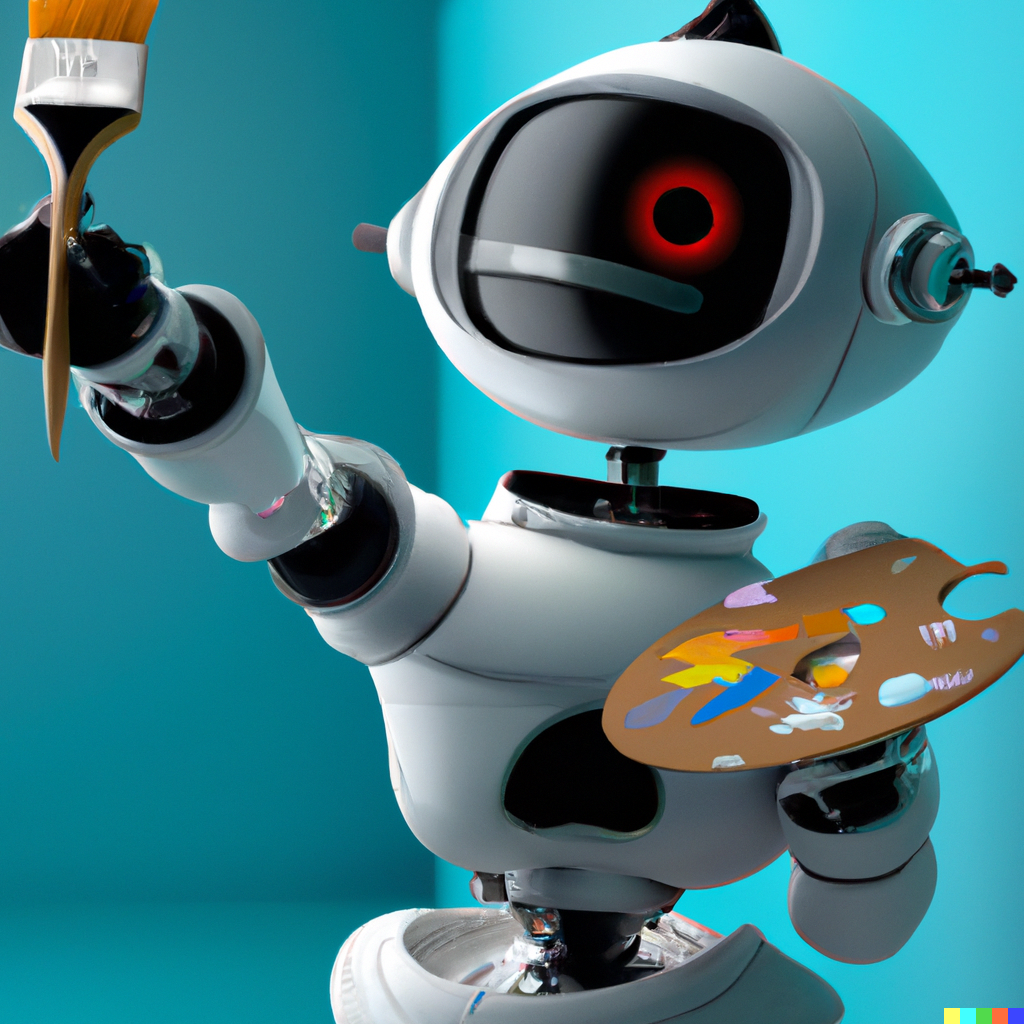
And I’ve made like 1000 variations of one thing trying to get the one picture that I might actually use. So a lot of it feels a little bit wasteful, but I wouldn’t be able to get anything near like the quality of the stuff that I’m making.
I don’t think I could even put together in Photoshop, it would just take too long, especially like the ornate decorations have the gold embellishment and the armor, the hairpin or whatever, really detailed stuff that I couldn’t find stock photos to buy those elements in, but I can generate them really quickly.
So for making covers faster. I’m pretty excited about it.
I know a lot of authors are skeptical, especially with the copyright thing, because I think copyrights really important person that doesn’t bother me, like you mentioned text is a huge deal.
So I’m going to brand my series with the typography anyway. And a lot of authors even if they can get cheap art, that’s great. They can’t put the nice text on. And it’s going to look unprofessional. So being able to just know, the picture shows the setting and the mood a little bit, but the genre is really type dependent.
Good designers will know which fonts to use to make sure you’re communicating the right genre for your book cover. And that’s a really important piece of book cover design.
So you can’t just kind of make everything by yourself, but you could get the art and then you could use a template or you could just Google Best fonts for fantasy, stuff like that and find a font that you like and hire someone to put the text on.
I think you can, I think the main thing is previously, some authors got more famous and more successful because they could afford really high quality cover art, it’s really good cover art costs 500 bucks, 2000 bucks. And if you don’t have that kind of a budget, and you’re trying to make it yourself, there’s an advantage to being successful and being able to afford the best cover designers.
I think this is going to open it up for a lot of other people who have good books, but don’t have good cover art, to suddenly step up their game in a significant way, and suddenly be those people who they were getting ahead because they can afford good cover designers. Maybe they won’t have as much of an edge anymore.
Joanna Penn
The other thing I want to emphasize is the fun and the delight aspect. Yeah, because I played with the text generation, Sudowrite, but also art generation.
It’s fun. I smile a lot. I’m like, Wow, that’s beautiful. Or that’s funny, or that’s unexpected.
And when I first started getting into this AI stuff, I just wanted to clone myself and generate stuff that was out of similar to my work so I could do more of my work. And now I’ve changed my mind.
And in fact, I did train a model in terms of the writing, I trained the model on my writing, and then what output was too similar to me, and I didn’t want it. I wanted a different mind. Do you feel that as an visual artist as well? Do you feel that sense of delight and fun as well?
Derek Murphy
Yeah, it’s completely addicting. And I’ve got an addictive personality. So like, I won’t go to bed, I’ll just be in bed clicking one more time, every new image, you have to re-spin. Because it’s like scrolling through social media, where you’re just looking for anything interesting that will catch your attention and give you that re-spin-dopamine boost. So everything else aside, I can see this becoming hugely popular, just because it’s fun to use.
Joanna Penn
Me too. And so if people listening are like, Yeah, I want to try that. I mean, when I was doing this a few months back, it was a little more technical. But it looks like things are getting easier and easier to use now, right?
You don’t have to be a programmer to use AI art tools.
Derek Murphy
There’s a bunch of new apps are coming out. I think even Midjourney has an app right now. But I don’t think it’s great.
Midjourney is kind of weird, because they make you use Discord, which is like a chat server. And then you put in your prompt. So when you first sign up with Midjourney and discord mid journey has its own website where you have your account, and it’ll show all your images.
And then discord has different chat areas, and a lot of them are public. So when you start off, there’ll be like 20 public areas, and you can see everybody else’s art and see what they’re working on.
But you can also create your own private channel in discord, I just created my own channel, and then you can import the whole Midjourney app. So now I’m just making all my images privately.
So another reason I don’t worry about the copyright is that no one else can see these images until I decide to share them. So if I just put them on my covers, like I’m not worried someone else is going to use the same thing. It feels like it’s, it feels like it’s hard to start using because of the whole discord thing.
But it takes a few hours to kind of get into it. And the results are just so impressive with so little effort that I think once people try it, they’ll get hooked pretty fast.
Joanna Penn
And as you say things are changing. I mean, I’ve really noticed, and we’re doing this because people have asked me in a way like even four months ago, people were saying to me, I don’t want to hear about AI, stop talking about it.
And now people are like, ‘Oh, tell me about this AI art.’
It’s almost like in the last three months, even as we talk this has gone mainstream, and it’s really hooked people because it’s so easy to see visually, rather than read stuff.
There are some prompts and examples with typography.
I only saw this today actually on Twitter website generrated.com with two R’s. It has images and prompts to use with DALL-E 2, presumably, you can also do that.
And they have generated movie posters, which people have started to talk about on Twitter as using for book cover design because it includes typography. So and that’s the first time I’ve seen it. I mean, this tweet only came out a couple of weeks ago as we as we record this, but it’s like, where do you think we’re going to be within a year’s time or three years time.
Derek Murphy
I think that is very likely and kind of crazy. I haven’t played around with the typography yet, but I have seen some of that stuff.
So I could say the title of my book ‘book cover design,’ this is what I want. And it’ll just make the whole finished thing that I could use.
I think will be there within a year, which is insane because then nobody will need cover designers anymore. They can just make their own art. I’m always on the side of making it easier for people to do creative things better.
So all authors are more suited towards writing. Writing is probably the main skill that they want to get good at. So it doesn’t make a lot of sense to invest a ton of time getting good at Photoshop or something.
But artwork is very, very valuable.
So I’ve seen people using it already for character concept, I have one friend who opened up a private discord for her own readership, so that they could come in and make character concepts for her books.
I’ve seen people make character concepts and post them on Kickstarter, because on Kickstarter, you really need images to communicate the feeling of the book if you’ve only got a rough draft.
And then I’ve seen people using like chapter design headers, I see people sell like the full page, illustrations or the chapter header, just like cute, cool little motif on the top of the book for book formatting, they can do those really well.
So you can get much better quality stuff that you just couldn’t even get before, even if you could afford it, designers weren’t capable of making stuff this cool. Now you can get it, it’s not just like an alternative or a replacement. It’s just something that didn’t exist before.
So for authors, I think it’s really exciting, because it’ll make publishing so much easier. And the cover is so important to getting their books read and sold.
So this is just like one lower barrier, so that people can focus on their writing and still have better results. But I do think it’s going to displace a whole lot of really big established business institutions.
Things are going to change in a big way in a couple of years. Not just in writing and digital artwork, but all the stock photo sites, all the stock music or video sites, a whole bunch of stuff.
So we’re at the very beginning of a really large shift. The controversy was because self publishing is a really small community. And we like to support cover designers, there’s only 10, or 20 really good cover designers that a lot of people use because they’re sort of the best in the industry.
And all of the cover designers are very, very against the idea of AI art, because it makes it more difficult for them to sell their services, because now there’s an alternative. So it’s right to be questioning the sources.
And it makes authors feel a little bit bad. I’ve had a lot of people tell me, you know, they love AI art and love the images, but they can’t support it because they want to support their cover designers. And that’s a nice feeling. It’s a nice idea.
But I think authors have sort of been trained, that we have to support each other. Like we’re all the underdogs, and cover designers and Self Publishers, we’re all fighting against the big traditional industry. So we have to support each other.
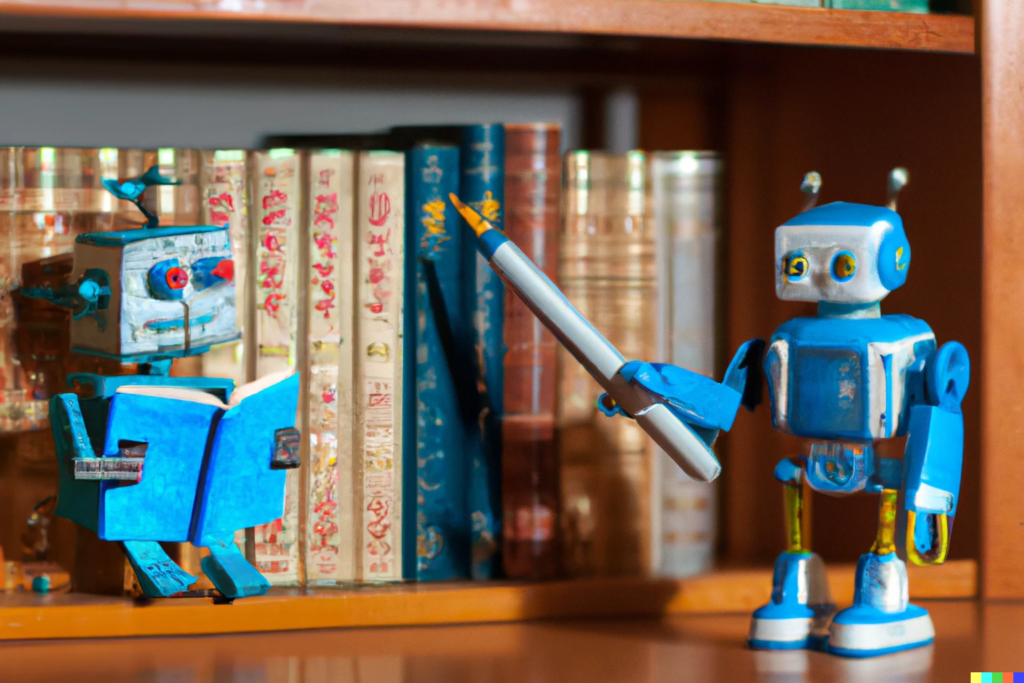
But I always feel for creative people, you have to be providing value. If you’re not providing value that people want at a price they can afford, that’s kind of on you.
As a cover designer, I wouldn’t want someone to hire me out of pity or to support me, I want them to get the best work however they can get it.
Joanna Penn
Kevin Kelly says ‘don’t race against the robots, the future is going to be basically working with the robots,’ and belongs to those people who can learn to use the tools.
And I read a lot of books about this stuff.
What they talk about is that people who don’t learn the new tools will be displaced by those who learned to use them and learn to drive them.
So I think you’re more likely to be hired as a book cover designer, because most people will not spend hours learning how to prompt things. And I don’t believe that ever will be an easy button.
There might be a button that says generate book cover. But as you say, it’s not just about that you have to do the iterations, you have to have a design principle in your head. And I feel like that is something that most people won’t do.
So I could format my own print books, but I don’t, I choose a book formatter/designer, because I don’t want to spend my time doing that.
There are lots of people who are going to say look, I want to hire a book cover designer, and if they generate images with Midjourney or whatever, I’m fine with that.
So I would say to people look, even if there is an easy button, people won’t use it.
We’re moving into this ever more abundant phase of art and music and words. And so we have to come back to the curation, the personal branding, the artistic direction, and almost build our products and everything around that.
Because otherwise in a world of abundance, it’s very hard to find anything, so curation becomes more and more important right?
Derek Murphy
Now, I totally agree. And you’re right that most people aren’t going to do it. I always feel like you know, this is awesome. Everybody should do it.
But the majority of writers, they haven’t heard of AI, they’re not interested. They’re going to probably hire a cover designer, regardless because they just don’t want to do it themselves.
I think that’s always going to be the case for the majority of authors, which means the authors who do self publish and do use AI are, if they’re able to put up something that looks amazing and looks different.
All of my book cover so far have been pretty, pretty on genre. They do what they’re supposed to do, but they’re not over the top amazing. I might experiment with doing some that are a little more creative, just because I sent out more, which is not something you can do on the low end, but you can do on the high end.
Joanna Penn
Absolutely. Exciting times ahead. So you’re sharing your experiments on your blog. Is that something you’re going to keep doing?
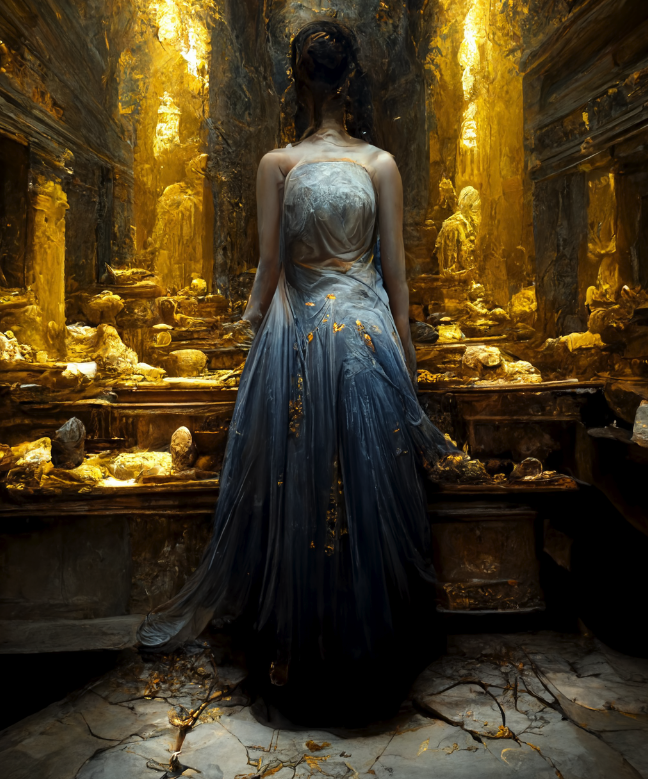
Derek Murphy
Yeah, I haven’t decided I almost want to make just like a dump file, because I have 1000s of pictures now. I started posting fantasy pictures. It’s also good for SEO. So I can put pictures of mermaids or pictures of vampires, and show up in Google search results or get a lot of traffic for people looking for images. But I really just have to finish my books, which are the main thing that I want to be doing.
Joanna Penn
Absolutely. So tell us a bit more about what you have in terms of books and courses.
Where people can find you and everything you do online?
Derek Murphy
So my main website is Creativindie.com, I’ve got a free book on Amazon, Book marketing is dead, and several more about publishing and book marketing.
More recently, I’ve been focused on writing so I have books about the craft of writing and some pretty long video series about writing. I’m on YouTube, I think I have 3 million views on YouTube as well. So I have tons of free content that’ll last a long time. And then I also have a limited number of spots for coaching or editing book cover design, that kind of stuff.
Joanna Penn
Brilliant. Well, thanks so much for your time. Derek. That was great. Thanks.
The post Using AI For Art, Images, And Book Covers With Derek Murphy first appeared on The Creative Penn.
Go to Source
Author: Joanna Penn

